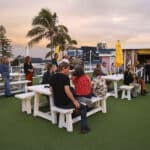TRAVEL
Celebrating On The Wild Side – Far From The Madding Crowd To Indonesia’s Hidden Gems

WORDS: Kat Johnston PHOTOGRAPHY Supplied
Some call it turning 50, but to me it’s the dreaded F-word. And as the F-word seemed to be fast approaching, I wanted to be as far away from Australia and remote as I could possibly get.
I also had a few other criteria—must be in the warm, lush tropics; surrounded by pristine natural beauty; and on the F-day itself, I needed to be by the ocean.
Enter destination, Raja Ampat.
Ever since I first heard of it, thoughts of these remote islands ticked away in the back of my mind. Set deep in the heart of the Coral Triangle, where the Pacific and Indian Oceans collide, more than 1500 islands form this unique and magical archipelago tucked away in Indonesian Southwest Papua. But enough of the geography lesson. What makes Raja Ampat so special is that it plays host to the richest biodiverse marine life on the planet. Not even our own Great Barrier Reef can match the sheer beauty and volume of spectacular underwater life that would soon have me mesmerised each day.
So back to the F-word. A friend said she would join me as it was also her own F-word birthday this year. Ali (Alison) flew 30 hours from the USA to blindly participate in my fantastical escape into the wilds. A decade has passed since we’d seen one another. We chose to meet in Bali for no other reason than for Ali to get a tiny taste of the Isle of the Gods.
The following night we took a short flight to the Indonesian capital, Jakarta, and at midnight we flew 4.5 hours to the West Papuan island of Sorong, the gateway to Raja Ampat. We were met at the airport by our hosts from Papua Paradise Resort just after dawn. Early morning wisps of tropical steam still swirled through the grasses and rose slowly up into the leaves of distant coconut trees. We were driven five minutes from the airport to a business hotel where our hosts checked us into a simple yet functional room to shower, take breakfast and sleep for a few hours.
Departing at 2pm, only one boat a day travels from Sorong to Birie Island in Raja Ampat. The adventure was now truly in motion. 90 minutes later, the over-water bungalows that define the location of Papua Paradise Resort finally came into view. As our boat neared the shore, traditional song greeted our ears and the lively talents of local village musicians joined the voices of staff to welcome our arrival.
Our room was one of the charming, older traditional Papuan-style, thatched-roof bungalows, situated just a few minutes stroll from the main house-pier, down a lush jungle pathway. From the wooden balcony of our bungalow, we gazed tirelessly across the glistening waters as nature put on her finest of shows, constantly changing with the movement of the tides, and gifting us with sunsets that can best be described by poets. The perfect setting for my F-day…
Unlike the majority of visitors to the region, neither Ali nor I are divers, but that didn’t detract from our experience in Raja Ampat. Each day brought with it a new snorkelling/dive location and an endless array of colour and underwater wildlife. The resort also has two thriving house-reefs, one on each side of Birie island, that we explored for hours. Professional divers told us there is no place better in the world than Raja Ampat, and with good reason. On one snorkelling trip, Ali and I went to an area known for Manta Rays. Expectations were rock bottom. No Mantas had been seen in the location for a week or so. But as we floated on the warm ocean’s surface and watched, suddenly we saw two Mantas. Then five. Then seven! They were magnificent. Hypnotic. They seemed almost unearthly.
During a conversation with a Canadian guest, I mentioned I was unable to scuba dive because I have back and leg injuries. He scoffed that he’s taught people to dive who don’t even have limbs. All one needs to do is put the tanks on in the water and they become weightless. In fact statistically the highest number of new divers are over the age of 60. I was a spring chicken! The next morning I undertook my Introduction to Diving course, and unlike most dive centres where you have to begin in the confines of a swimming pool, I was taught to dive down to 12 metres amongst unspoiled coral reefs. At one point, from beneath the waters I looked up towards the sky through an extraordinary mass of hundreds of swirling, glistening silver fish. It was unlike anything I have ever experienced and will never forget.
Being so remote, Papua Paradise Resort includes all meals. The food was surprisingly good, with a buffet-style meal served at breakfast, lunch and dinner catering to the dietary needs of all guests. The resort staff were exceptional with a genuine local charm that’s often hard to find these days. The manager and diving instructors also went out of their way to make sure every guest had a memorable experience.
To make the most of a trip to Raja Ampat, stay at least 7 nights. The multitude of underwater wildlife as well as the above-ground rich, tropical landscapes and endless, uninhibited views are hard to express. It is a soulful feast for your eyes, your mind and your body. I felt nourished in ways I hadn’t felt for years and will definitely return.
Leaving the turquoise waters of Raja Ampat, we then took a different travelling trajectory, heading back east and inland to the remote central highlands of Java. Here, we stayed at a truly enchanting hotel called MesaStila. Built originally in the 1920s as a Dutch-owned coffee plantation, the property was later bought by a creative and visionary Italian woman who spent a decade curating and building every element onsite, transforming a vast hilltop Javanese coffee plantation into a remarkable hotel property. MesaStila is rich in history, culture and nature, and still a working coffee plantation, with so much space and so many little nooks to explore and relax in, there was not enough time to enjoy them all. A charming old train station, built in Mayong in 1873, sits as the main reception area, while Indonesia’s only authentic hammam spa is located directly below the serene infinity pool that overlooks the mountains. Strategically placed, beautifully-unique Indonesian joglos (antique wooden houses) form the guest accommodation, many with magnificent volcanic views. From our room, the scenery was breathtaking, and on clear days I could actually see four volcanos in the distance.
MesaStila attempts to preserve the local culture and educate guests by offering a number of free resort activities. A Jamu-woman from the village comes every morning at 5am to prepare four types of Jamu for guests to have with breakfast. Jamu is a traditional Indonesian medicine made from roots, herbs, flowers, bark and spices, drunk as a tonic each day and chosen specifically for each person depending on their wellness needs. Guests can participate in a weekly schedule of free activities such as batik-making with a local artisan, Javanese dancing, daily morning yoga and unmissable coffee plantation tour. We learned the difference between the four types of coffee plants grown onsite and were shown how coffee is transformed from being a red pod on a small tree to a roasted brown bean, then ground to become a steaming rich Javanese brew. We enjoyed the complimentary afternoon tea served with different homemade treats and took the time to quietly nestle in the sumptuous day beds located on the veranda of the original Plantation House and watch the sun go down.
MesaStila also offers a selection of customised activities and day trips including cycling adventures, bathing in 1000-year-old Hindu hot springs, and epic volcanic treks. We chose to visit the world’s largest Buddhist temple called Borobudur, built in the 9th century and widely considered to be one of the seven wonders of the world. Borobudur is approximately drive 1.5 hours from MesaStila. Expecting busloads of tourists, we were amazed (and delighted) to have the entire compound almost to ourselves. This turned out to be on account of the Muslim fasting period Ramadan, which meant there was very little domestic tourism at that time, something to consider if you are planning a trip to such popular destinations. Otherwise the general advice is to go early to Borobudur and let the other tourists sleep in. And hire a local guide—you’ll receive a wealth of information and appreciation for the history, design and architecture you’d otherwise be oblivious to.
If you are looking for a destination not too far from Australia where you can take the time to relax and immerse yourself in something truly unique, MesaStila and the surrounding region is a very special place indeed. You’ll wish you could stay longer.
We finished our trip with a few nights in Bali before taking our respective international flights home.
I am now the F-word. I have disappeared and re-emerged. I have more confidence and vitality than I’ve felt in years. I’m stronger than I thought. I guess sometimes you just have to say, “’F’ it”, and do it anyway.
To reach Raja Ampat, flights from Australia depart daily from Jakarta to Sorong at midnight.
MesaStila can be reached from four different airports around central Java and is also an easy 1.5 hours flight from Bali.
Our travel itinerary was developed in collaboration with luxury boutique travel company, Secret Retreats. Secret Retreats seeks to unveil the essence of Asia and their concierge service delivers impeccable advice and support.
For more information visit www.secret-retreats.com





















